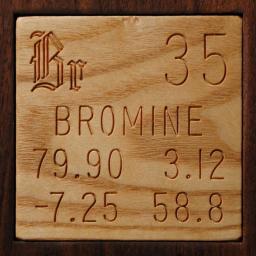H and L tubes.
I saw a rather alarming listing on eBay for these two bromine tubes, listed as "Low & High Bromine Scientific Tube tubes LOT" by a seller who obviously didn't know a lot about what bromine is. The seller offered "I've no idea what these are. They are marked with some warnings, etc." Some warnings? Well, fortunately they arrived intact and now they are in a safe place where people appreciate the need to keep bromine in a safe place.
The "High & Low" bit appears to be pure conjecture on the part of the seller, based on the letters "H" and "L" hand-written on the otherwise printed labels. So far as I can tell both tubes contain an identical pressure of bromine (evidenced by the fact that there are the same size of small beads of liquid bromine in both), so H and L are not referring to high and low pressure as one might have expected. I can't think of anything else that would be characterized by high and low, so I'm going to assume that the H and L designations are some private little code whose meaning is probably lost to history.
Reader Graham Fraser offers the following theory:Hello Mr. Gray,
I very much enjoyed browsing your periodic table website and I would like to commend you on the wonderful work (both on the web and in the wood). I read the section detailing the pair of bromine tubes you purchased from a seller on ebay and the fact that they had the letters 'H' and 'L' written on them and you believed the seller misinterpreted the meaning of the letters to mean High and Low pressure. I remember a demonstration from high school chemistry class where two tubes of bromine were used. One was placed in an ice bath while the other was kept at room temperature. As you pointed out both tubes likely have the same pressure, and as a result when one is subjected to 'Low' temperature the gas in the tube condenses and leaving a liquid in the tube and the "air" in the tube goes clear. A fairly dramatic demonstration that I still remember some 14 years later.
I hope this contributes something to your site, but clearly that is just my interpretation of the 'H' and 'L' to mean 'High' and 'Low' temperature based on the class demonstration I recall.
Cheers,
Graham Fraser Well, it was a good theory, but wrong. I have now learned that in fact H and L do refer to pressure, just not pressure of bromine. It turns out these tubes contain identical amounts of bromine, but different amounts of Air. The H tube likely contains about one atmosphere of air, while the L tube contains much less, maybe even mostly vacuum (other than the bromine). Radiation expert William Kolb, a long-time correspondent of mine, reports that he happened to be researching bromine on the web, and google lead him to both my description of this sample, and to a company that sells tubes exactly like this. Putting two and two together, he emailed me their instruction sheet, which explains that these tubes are designed to demonstrate the phenomenon of diffusion.
Both tubes are stuck into an alcohol/dry ice cooling bath, which causes all the bromine in them to condense and solidify at the cold end of the tube. The tubes are then removed and allowed to warm up. In the tube with only bromine, the whole space of the tube fills up pretty much uniformly with purple bromine vapor, while in the tube that also has air in it the bromine takes much longer to diffuse to the far end of the tube.
So there you have it, after only four years, the definitely correct answer has been determined! And if you want a set like this, they are still available from scientific suppliers, as are similar pairs of tubes containing iodine.
Source: eBay seller sellitontheweb
Contributor: Theodore Gray
Acquired: 22 November, 2003
Text Updated: 12 March, 2007
Price: $10
Size: 12"
Purity: >99%
|
| 
|
|